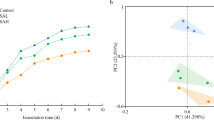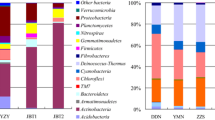Abstract
Microorganisms as essential components of soils have important roles in biochemical cycles of organic matter conversion into nutrients available for an uptake by plants. Soil salinity is an important factor that affects microbial diversity and activity. The aim of this study was to investigate the effects of soil salinity on microbial biomass, nitrification rate and urease activity within the rhizosphere of sugarcane. Microbial activity, i.e., urease activity and nitrification rates in saline soil were lower than those in non-saline soil under sugarcane cultivation. Microbial diversity was assessed using different techniques for DNA extraction from the studied soils and the single-strand conformation polymorphism (SSCP) analysis of DNA extracts. It was found that saline soil had lower microbial biomass and respiration rate, but higher diversity of soil bacteria as compared to those within non-saline soil.



Similar content being viewed by others
REFERENCES
A. Parvaiz and S. Satyawati, “Salt stress and phytobiochemical responses of plants—a review,” Plant Soil Environ. 54, 89–99 (2008).
A. P. Gandhi and K. V. Paliwal, “Mineralization and gaseous losses of nitrogen from urea and ammonium sulphate in salt-affected soils,” Plant Soil 45, 247–255 (2004).
B. C. Yuan, X. G. Xu, Z. Z. Li, T. P. Gao, M. Gao, X. W. Fan, and H. M. Deng, “Microbial biomass and activity in alkalized magnesic soils under arid conditions,” Soil Biol. Biochem. 39, 3004–3013 (2007).
C. García, T. Hernández, and F. Costa, “Microbial activity in soils under Mediterranean environmental conditions,” Soil Biol. Biochem. 26, 1185–1191 (1994).
C. L. A. Asadu, I. A. Nwafor, and G. U. Chibuike, “Contributions of microorganisms to soil fertility in adjacent forest, fallow and cultivated land use types in Nsukka, Nigeria,” Int. J. Agric. For. 5 (3), 199–204 (2015).
C. Yeates, M. R. Gillings, A. D. Davison, N. Altavilla, and D. A. Veal, “PCR amplification of crude microbial DNA extracted from soil,” Lett. Appl. Microbiol. 25, 303–307(1997).
C. C. Young, R. L. Burghoff, L. G. Keim, V. Minakbernero, J. R. Lute, and S. M. Hinton, “Polyvinylpyrrolidone-agarose gel electrophoresis purification of polymerase chain reaction-amplifiable DNA from soils,” Appl. Environ. Microbiol. 59, 1972–1974 (1993).
D. G. Zvyagintsev, G. M. Zenova, and G. V. Oborotov, “Moderately haloalkaliphilic actinomycetes in salt-affected soils,” Eurasian Soil Sci. 42, 1515–1520 (2009).
E. B. Hollister, A. S. Engledow, A. J. M. Hammett, et al., “Shifts in microbial community structure along an ecological gradient of hypersaline soils and sediments,” ISME J. 4, 829–838 (2010).
E. E. Andronov, S. N. Petrova, A. G. Pinaev, et al., “Analysis of the structure of microbial community in soils with different degrees of salinization using T-RFLP and real-time PCR techniques,” Eurasian Soil Sci. 45, 147–156 (2012).
E. L. Madsen, “Microorganisms and their roles in fundamental biogeochemical cycles,” Curr. Opin. Biotechnol. 22, 3456–464 (2011).
E. Lamizadeh, N. Enayatizamir, and H. Motamedi, “Isolation and identification of plant growth-promoting rhizobacteria (PGPR) from the rhizosphere of sugarcane in saline and non-saline soil,” Int. J. Curr. Microbiol. Appl. Sci. 5 (10), 1072–1083 (2016).
E. D. Vance, P. C. Brookes, and D. S. Jenkinson, “An extraction method for measuring soil microbial biomass-C,” Soil Biol. Biochem. 19, 703–707 (1987).
E. V. Blagodatskaya, S. A. Blagodatskii, and T. H. Anderson, “Quantitative isolation of microbial DNA from different types of soils of natural and agricultural ecosystems,” Microbiology (Moscow) 72, 744–749 (2003)
F. Nourbakhsh and C.M. Monreal, “Effects of soil properties and trace metals on urease of calcareous soils,” Biol. Fertil. Soils 40, 359–362 (2004).
G. M. Zenova, M. S. Dubrova, A. I. Kuznetsova, et al., “Ecological and taxonomic features of actinomycetal complexes in soils of the Lake Elton basin,” Eurasian Soil Sci. 49, 213–216 (2016).
H. Hasbullah and P. Marschner, “Residue properties influence the impact of salinity on soil respiration,” Biol. Fertil. Soils 51 (1), 99–111 (2015).
H. Kheyrodin and H. Antoun, “Measurement of microbial activity and applicability of dissolved DNA as indicator of microbial activity in pasturage soil,” Afr. J. Agric. Res. 6, 3445–3450 (2011).
H. Pathak and D. L. N. Rao, “Carbon and nitrogen mineralization from added organic matter in saline and alkali soils,” Soil Biol. Biochem. 30, 695–702 (1998).
H. Yang, J. Hu, X. Long, Z. Liu, and Z. Rengel, “Salinity altered root distribution and increased diversity of bacterial communities in the rhizosphere soil of Jerusalem artichoke,” Sci. Rep. 6, 20687 (2016).
J. Bassam, G. Caetano-Anollés, and P. M. Gresshoff, “Fast and sensitive silver staining of DNA in polyacrylamide gels,” Anal. Biochem. 196, 80–83 (1991).
J. Borneman, P. W. Skroch, K. M. O’Sullivan, et al., “Molecular microbial diversity of an agricultural soil in Wisconsin,” Appl. Environ. Microbiol. 62, 1935–1943 (1996).
J. P. Anderson, A. L. Page, R. H. Miller, and D. R. Keeney, “Soil respiration,” in Methods of Soil Analysis, Part 2: Chemical and Microbiological Properties (Soil Science Society of America, Madison, 1982), pp. 831–871.
J. Rousk, F.K. Elyaagubi, D. L. Jones, and D. L Godbold, “Bacterial salt tolerance is unrelated to soil salinity across an arid agroecosystem salinity gradient,” Soil Biol. Biochem. 43, 1881–1887 (2011).
J. Rousk, P.C. Brookes, and E. Baath, “Contrasting soil pH effects on fungal and bacterial growth suggest functional redundancy in carbon mineralization,” Appl. Environ. Microbiol. 75, 1589–1596 (2009).
J. Rowland and B. Nguyen, “Use of polyethylene–glycol for purification of DNA from leaf tissue of woody plants,” Biotechniques 14, 734 (1993).
J. Shi, H. R. Lin, X.F. Yuan, X. C. Chen, C. F. Shen, and Y. X. Chen, “Enhancement of copper availability and microbial community changes in rice rhizospheres affected by sulfur,” Molecules 16, 1409–1417 (2011).
J. Wichern, F. Wichern, and G. Joergensen, “Impact of salinity on soil microbial communities and the decomposition of maize in acidic soils,” Geoderma 132 (1–2), 100–108 (2006).
J. Zhou, M. A. Bruns, and J. M. Tiedje, “DNA recovery from soils of diverse composition,” Appl. Environ. Microbiol. 62, 316–322 (1996).
J. M. Chaparro, A. M. Sheflin, D. K. Manter, and J. M. Vivanco, “Manipulating the soil microbiome to increase soil health and plant fertility,” Biol. Fertil. Soils 48, 489–499 (2012).
M. A. Tabatabai and J. M. Bremner, “Assay of urease activity in soils,” Soil Biol. Biochem. 4 (4), 479–487 (1972).
M. Akhtar, F. Hussain, M. Y. Ashraf, T. M. Qureshi, J. Akhter, and A. R. Awan, “Influence of salinity on nitrogen transformations in soil,” Commun. Soil Sci. Plant Anal. 43 (12), 1674–1683 (2012).
M. Irshad, and T. Honna, S. Yamamoto, A.E. Eneji, and N. Yamasaki, “Nitrogen mineralization under saline conditions,” Commun. Soil Sci. Plant Anal. 36, 1681–1899 (2005).
M. Tejada, C. Garcia, J. Gonzalez, and M. Hernandez, “Use of organic amendment as a strategy for saline soil remediation: influence on the physical, chemical and biological properties of soil,” Soil Biol. Biochem. 38, 1413–1421 (2006).
M. S. Mavi and P. Marschner, “Salinity affects the response of soil microbial activity and biomass to addition of carbon and nitrogen,” Soil Res. 51 (1), 68–75 (2013).
N. Rietz and R. J. Haynes, “Effects of irrigation-induced salinity and sodicity on soil microbial activity,” Soil Biol. Biochem. 35, 845–854 (2003).
P. K. Gupta, Soil, Plant, Water and Fertilizer Analysis (Agrobios, Jodhpur, Raj., 2004).
R. Jacoby, M. Peukert, A. Succurro, A. Koprivova, and S. Kopriva, “The role of soil microorganisms in plant mineral nutrition—current knowledge and future directions,” Front. Plant Sci. 8, 1–19 (2017).
R. Calbrix, S. Barray, O. Chabrerie, L. Fourrie, and K. Laval, “Impact of organic amendments on the dynamic of soil microbial biomass and bacterial communities in cultivated land,” Appl. Soil Ecol. 35, 511–522 (2007).
R. J. Steffan and R. M. Atlas, “Polymerase chain-reaction—applications in environmental microbiology,” Annu. Rev. Microbiol. 45, 137–161 (1991).
R. J. Steffan, J. Goksoyr, A.K. Bej, and R. M. Atlas, “Recovery of DNA from soils and sediments,” Appl. Environ. Microbiol. 54, 2908–2915 (1998).
R. Ortíz-Castro, H. A. Contreras-Cornejo, L. Macías-Rodríguez, and J. López-Bucio, “The role of microbial signals in plant growth and development,” Plant Signal. Behav. 4 (8), 701–712 (2009).
R. Setia, P. Marschner, J. Baldock, D. Chittleborough, and V. Verma, “Relationships between carbon dioxide emission and soil properties in salt-affected landscapes,” Soil Biol. Biochem. 43, 667–674 (2011).
R. D. Laura, “Effects of neutral salts on carbon and nitrogen mineralization of organic matter in soil,” Plant Soil 41, 113–127 (1974).
S. F. Wright and A. Upadhyaya, “A survey of soils for aggregate stability and glomalin, a glycoprotein produced by hyphae of arbuscular mycorrhizal fungi,” Plant Soil 198, 97–107(1998).
U. Kumar, V. Kumar, and J. P. Singh, “Effect of different factors on hydrolysis and nitri?cation of urea in soils,” Arch. Agron. Soil Sci. 53, 173–182 (2007).
V. N. Wong, R. C. Dalal, and R. S. Greene, “Carbon dynamics of sodic and saline soils following gypsum and organic material additions: laboratory incubation,” Appl. Soil Ecol. 41 (1), 29–40 (2009).
W. T. Frankenberger and F. T. Bingham, “Influence of salinity on soil enzyme activities,” Soil Sci. Soc. Am. J. 46, 1173–1177 (1982).
Y.-Z. Su, T.-N. Liu, X.-F. Wang, and R. Yang, “Salinity effects on soil organic carbon and its labile fractions, and nematode communities in irrigated farmlands in an arid region, northwestern China,” Sci. Cold Arid Reg. 8 (1), 46–53 (2016).
Y. Yao, Z. He, M. J. Wilson, and C. D. Campbell, “Microbial biomass and community structure in a sequence of soils with increasing fertility and changing land use,” Microb. Ecol. 40, 223–237 (2000).
Y. L. Tsai, and B. H. Olson, “Rapid method for direct extraction of DNA from soil and sediments,” Appl. Environ. Microbiol. 57 (4), 1070–1074 (1991).
Author information
Authors and Affiliations
Corresponding author
Rights and permissions
About this article
Cite this article
Lamizadeh, E., Enayatizamir, N. & Motamedi, H. Difference in Some Biological Properties of Saline and Non-saline Soil under Sugarcane Cultivation. Eurasian Soil Sc. 52, 690–695 (2019). https://doi.org/10.1134/S1064229319060085
Received:
Revised:
Accepted:
Published:
Issue Date:
DOI: https://doi.org/10.1134/S1064229319060085




